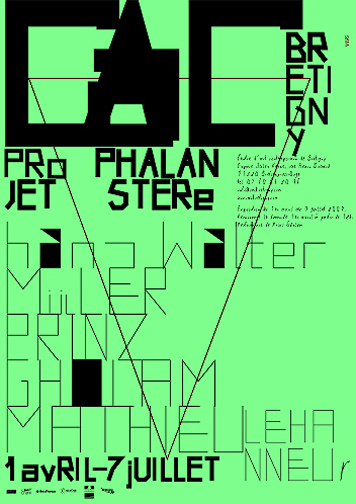
Vier5, Poster for Exhibition Phalanstère with Prinz Gholam, Hans Walter Müller and Matthieu Lehanneur
I first saw the work of French design team Vier5 (Marco Fiedler and Achim Reichert) in Tokion magazine a couple of years ago, but for almost a decade they have been creating what they call "new forward-looking images in the field of visual communication." They have also repeatedly referred to their work as modern — by which I take them to mean not Modern as it has come to be understood, but modern as in contemporary. The duo is adamant that our times require their own letterforms — the typefaces of yesterday will not suffice. This is an ambitious project, and it carries with it an implicit critique, not so much of the Modernists of a half century ago, but of the decades of designers since who have passively forfeited the idea of being new to their predecessors.

Vier5, Cover of Compact and Finite They Pass. Wow for exhibition of Viola Klein at the Frankfurter Kunstverein
In a 2004 interview Vier5 said, "you cannot work with modern pictures and at the same time use the typefaces of the last 50 years. The time for these typefaces is gone." Judging by their body of work these modern pictures require typography that could be described as post-digital. The letterforms they have made for forward-thinking clients like the Center for Contemporary Art in Bretigny, France, and magazines like Colette and Foto, look handmade — but by a hand that has spent a lot of time on the computer. Jagged pixel-like edges appear stretched and inconsistent in a way that a computer would have to be coaxed into rendering. The forms are geometric but our ideas of balance and proportion are inverted. The digital experience informs their work but does not define it.

Vier5, Invitation for exhibition of Nicolas Chardonthe, Centre of Contemporary Art in Bretigny
This mixture of the organic and the technical brings to mind another proponent of new typography. In 1928, Jan Tschichold wrote in The New Typography: "It was left to our age to achieve a lively focus on the problem of 'form' or design. While up to now form was considered as something external, a product of the 'artistic imagination'...today we have moved considerably closer to the recognition of its essence through the renewed study of nature and more especially to technology (which is only a kind of second nature)."

Vier5, Poster for exhibition by David Lamelas, Centre of Contemporary Art in Bretigny
Tschichold's careful distinction between man's imagination and nature reflects a complicated feature of modernity. As Bruno Latour explored in We Have Never Been Modern, modernity is on the one hand characterized by parsing the differences between things like culture and nature, while at the same time it constructs systems that mix politics, science, technology, nature, and so on. Vier5's work, with its blending of the hand-made and the digital, embodies this contradictory quality. Latour suggests moving beyond a worldview of distinctions and instead accepting continuity between eras, cultures, and epistemes — essentially rejecting the idea of newness. This approach allows us to move beyond a historically fixed idea of modernity and to embrace the connections between Tschichold and Vier5.
It is easy to fall back on clichés about the end of history and the post-modern condition, but this historical awareness can be just a convenient excuse for historicism. I'm not completely convinced that every historical moment requires new letterforms (this assertion contradicts one aspect of Modernism I find myself nostalgic for — the goal of universality and commonality), but Vier5's unapologetic use of the word modern and their quest for the new is gutsy. Their work raises the question: is there a difference between being new and being modern?
